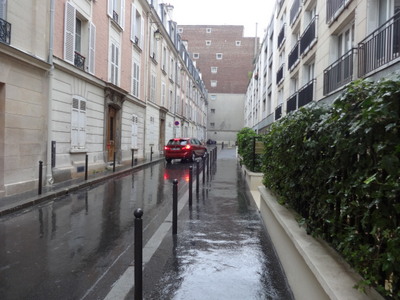
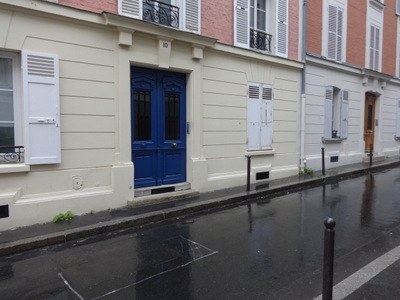 We were promised a quiet location with no traffic, and they weren't kidding. This is our tiny, one-lane, dead-end street. As you can see, it rained off and on before, during, and after our arrival.
We were promised a quiet location with no traffic, and they weren't kidding. This is our tiny, one-lane, dead-end street. As you can see, it rained off and on before, during, and after our arrival. Wednesday, June 12, The rest of the way from Tallahassee to Paris, but without counterfeiting
Written 13 June 2019
We have arrived at or connected through Charles De Gaulle airport many, many times now, but experience there is useless. Its record is unbroken. Every single time, including this one, that we have entered it, it has been completely different from any other time. This time, for example, they deployed both oversized jetways and got all 300 of us out of the plane into a wide hallway in a surprisingly short time. Unfortunately, that hallway ended a couple of yards later in a single escalator barely two people wide, so we waited around a good deal to get on it. At the top, it opened out again; they couldn't have installed two escalators? As you may have read in my 2014 diary, the route from the plane to passport control has sometimes been positively Byzantine, but this time, even though we were supposedly once more in the M gates of terminal 2E, once we were past the escalator, we walked in a straight line with lots of other folks, but still for miles, to reach the little train that took us straight to the usual large passport-control hall (not the same one as last year, but of the same sort). The lines were short, but the crowd-control ribbons were up in their full serpentine glory, so we walked for a solid five minutes, back and forth and back and forth, to cross one room. Having learned his lesson last year, David was not tempted to duck under any of them.
From there, it was a short walk to baggage claim, where our bags emerged promply and signs directed us to the official taxi queue (I hadn't yet dealt with giving my new phone number to Uber). The price has gone up but is still an eminently reasonable flat 50 euros.

 We were promised a quiet location with no traffic, and they weren't kidding. This is our tiny, one-lane, dead-end street. As you can see, it rained off and on before, during, and after our arrival.
We were promised a quiet location with no traffic, and they weren't kidding. This is our tiny, one-lane, dead-end street. As you can see, it rained off and on before, during, and after our arrival.
Beyond the end of the bushes along the right-hand side is a row of nine locked garage doors, to private garages tucked under the building. Back at that end of the street, the sidewalk widens out and has a low curb, so a car can make a three-point turn rather than backing out of the street. (I'm sure the large UPS van making a delivery next door as I write is glad of that.)
Our big blue door is at #10, the fifth of six that open off the narrow sidewalk on the left-hand side. Olga the apartment manager appeared promptly (with her two small daughters in tow) to issue us keys and to check us out on the apartment (she lives in the apartment building directly across the street from us). A fob on each of our key rings buzzes us through the blue door, then through an inner glass door. One step beyond that point, a key opens our ground-floor apartment, to the right. The shuttered window to the right of the blue door is ours. The window in the back bedroom opens on an air shaft, as does the tiny, high window in the bathroom.
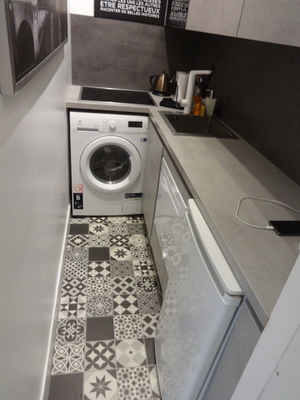
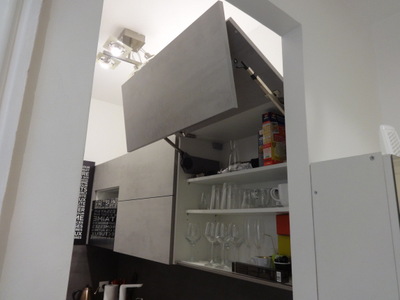 The apartment is small. It consists of a back room with a double bed and some modular-cube shelving; a front room with a sofa that folds out into a double bed; a bathroom with a toilet, modernistic sink, and an excellent glass-enclosed shower; and crosswise between the front and back rooms, a narrow kitchen, shown here at the left. Nearest the camera is the under-the-counter fridge, then the half-size dishwasher (just one drawer that pulls out and holds a single layer of dishes), then the sink, then (beyond the cabinets and above the electric kettle) a built-in microwave with all the markings scrubbed off the controls. Directly opposite the camera is the ceramic cooktop and below it not an oven but a combination washer and dryer.
The apartment is small. It consists of a back room with a double bed and some modular-cube shelving; a front room with a sofa that folds out into a double bed; a bathroom with a toilet, modernistic sink, and an excellent glass-enclosed shower; and crosswise between the front and back rooms, a narrow kitchen, shown here at the left. Nearest the camera is the under-the-counter fridge, then the half-size dishwasher (just one drawer that pulls out and holds a single layer of dishes), then the sink, then (beyond the cabinets and above the electric kettle) a built-in microwave with all the markings scrubbed off the controls. Directly opposite the camera is the ceramic cooktop and below it not an oven but a combination washer and dryer.
The two storage cabinets do have these cool Delorean-style gull-wing doors.
The place has only one closet, in the entryway, which is two feet wide and 7" deep. It holds three umbrellas and some rails you can use as a shoe rack. The front room has a chest of drawers, so I consolidated the contents of two of the drawers into the third so that I'd have someplace to put my stuff. David's using the shelving in the back room. The front room also has the flatscreen TV, DVD player, and wifi router, a 50's-style egg-shaped white formica coffee table(with a smaller replica in black that fits under it), a semicircular padded chair, and a small round dining table with four plastic chairs. Not a lot of floor space left over. The coffee table only fits because it's pushed back into the shallow recess below the ornate marble mantle-piece. If the recess was ever a functioning fireplace, it must have projected back into what's now the entry hall inside the blue door.
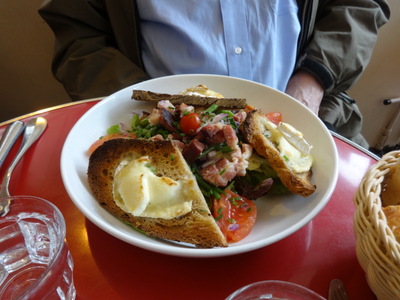
 First order of business after we checked in and dropped off our bags, though, was lunch. We settled at La Maison, a few blocks away. David ordered a grilled goat-cheese salad (left) with lardons and and green beans.
First order of business after we checked in and dropped off our bags, though, was lunch. We settled at La Maison, a few blocks away. David ordered a grilled goat-cheese salad (left) with lardons and and green beans.
I chose the "Scottish" salad—a cold lentil salad tossed with crawfish tails, slices of smoked salmon, and toasts, plus the usual green salad. Unfortunately, we agreed that the salads were not up to the usual French standard. Everything was badly underseasoned (a liberal addition of salt helped the vinaigrette on the greens, but the lentils, crawfish, and salmon were all very bland, and David's lardons were gristly, cold, and tasteless). Probably won't go back there.
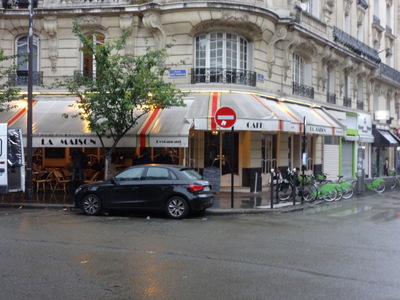
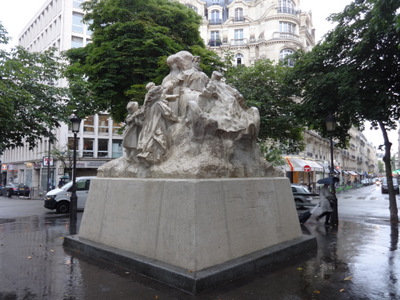 The restaurant itself is shown here at the left. It's on the Place St. Ferdinand, so I assumed the statue in the center would be St. Ferdinand, but closer investigation revealed that it's Leon Serpollet (1858–1907), French industrialist and pioneer of steam automobiles. In 1902, he set a world land speed record of 75.06 mph; not clear to me why he's portrayed with people climbing his pedestal.
The restaurant itself is shown here at the left. It's on the Place St. Ferdinand, so I assumed the statue in the center would be St. Ferdinand, but closer investigation revealed that it's Leon Serpollet (1858–1907), French industrialist and pioneer of steam automobiles. In 1902, he set a world land speed record of 75.06 mph; not clear to me why he's portrayed with people climbing his pedestal.
The plan (or at least my plan) was then to walk over to a nearby Metro station, charge up our Navigo Découverte cards (purchased last year) with a week's unlimited travel, and take the bus three stops to the museum of counterfeiting. But David declared he'd rather take a nap. I had suspected this might happen, so I hadn't reserved tickets for the date. He went back to the apartment while I went on to charge up the cards by myself. That turned out to be a snap—I set a card in its little cradle, shoved my credit card in the slot, specified what I wanted on the touch screen, and followed the instructions that appeared there. I then thought about going on to the museum by myself, but decided it would be too much—I still had my wifi and Uber setups to do—so I headed for home. On the way, I stopped in at a conveniently located Carrefour City (a cross between a 7-11 and the Harrod's food halls) for milk, butter, cheese, and jam.
Written 14 June 2019
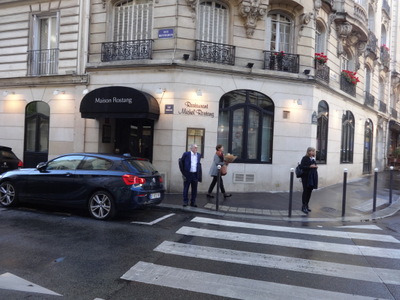
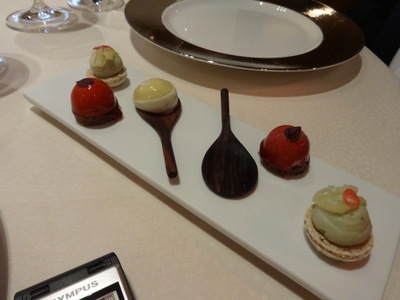 Our restaurant for the evening, which I selected from David's short list of 19, was Michel Rostang. We went there last year, and it was one of the few he repeated. In the course of the evening, though, he made clear that he didn't remember the place at all and thought it was one of the new places he picked out to try. Oh well, the food was still just as good.
Our restaurant for the evening, which I selected from David's short list of 19, was Michel Rostang. We went there last year, and it was one of the few he repeated. In the course of the evening, though, he made clear that he didn't remember the place at all and thought it was one of the new places he picked out to try. Oh well, the food was still just as good.
At the left is the restaurant as we approached it; thought I'd better get the photo while it was still light.
As we did last time, we ordered the eight-course tasting menu, but in places like this, you never get just eight things to eat. When offered an apperitif, David ordered a glass of champagne and was delighted to get a 2008 vintage Veuve Cliquot. And another thing about places like this is that they never put a glass of alcohol on the table without also serving you at least a small thing to eat with it, and everyone at the table gets the munchie, whether they're drinking or not, so before we even got the first amuse-bouche, we were served tiny "club sandwiches" of smoked "sarde" (which I think is just Italian for "sardine"). I think the French definition of a "club sandwich" is any sandwich made on retangular sliced bread. In this case, each piece of crustless toast was about an inch square, and several of them alternated on a little decorative bamboo skewer with layers of the tasty fish spread. Delicious.
The first "real" amuse-bouche is shown at the right. On the wooden spoons, are domes of chevre (goat-cheese) mousse with tiny dice of zucchini inside. The red ones are foie gras glazed with beet-root jelly on little slightly sweet crispy shortbread disks, the others are soft nut macaroons with a mousse of fourme d'Ambert (a blue cheese). The pink dots on them are tiny begonia petals, all the rage as a garnish a couple of years ago.
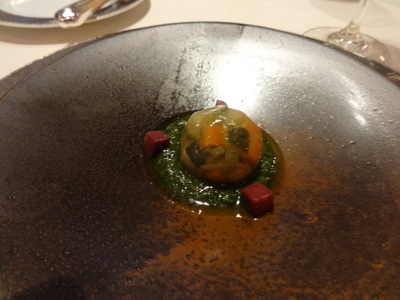
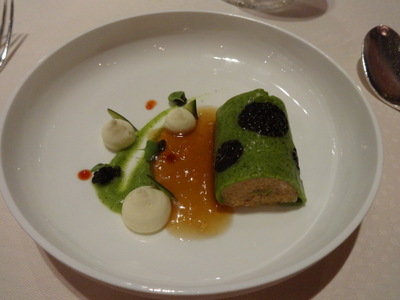 The second amuse-bouche was a little dome of perfectly seasoned cooked vegetables resting on a bed of parsley purée and surrounded by three small red cubes, which I took to be cooked beet but turned out to be chewy meat sausage! The dome of vegetables, which we expected to be embedded in jelly, were in fact enclosed in one of those clear agar bubbles we encountered so many of when we toured Burgundy in 2009.
The second amuse-bouche was a little dome of perfectly seasoned cooked vegetables resting on a bed of parsley purée and surrounded by three small red cubes, which I took to be cooked beet but turned out to be chewy meat sausage! The dome of vegetables, which we expected to be embedded in jelly, were in fact enclosed in one of those clear agar bubbles we encountered so many of when we toured Burgundy in 2009.
The first of our eight courses was crab with caviar. The chef had made a sort of sheet of minced zucchini (perhaps bound together with more agar) that included patches of caviar, then rolled it around a cylinder of cold shredded spider-crab meat. On the side were a comet of zucchini purée, some little puffs of a very smooth puréed white vegetable (probably celery root), each supporting a little wedge of zucchini, and a few dabs of extra caviar, each topped with a tiny lemon-balm leaf. At the table, the waiter spooned on the amber sauce, which was a semijelled consommé of spider crab.
Last year, I mentioned that the chef was no longer active in the kitchen but had passed the baton to a successor (NIcholas Beaumann). This year, though, he suited up in his whites and came out to greet us, as did his wife, who still runs the dining room. (And Beaumann did the cooking.)
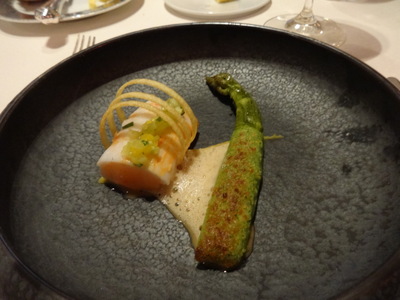
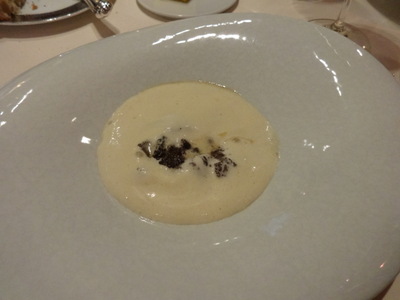 The second course was langoustines and asparagus. We had that combination last year, too, but in that case, it was served on a bed of thinly sliced asparagus, whereas this year it was sided with a single large, perfect spear. The thin, spiral-shaped cookie surrounding the langoustines was the same, though. The cylinder of langoustines consisted of a cooked langoustine tail, sliced or otherwise flattened so that it could surround and enclose a cylindrical log of tartare of raw langoustine tails. A yummy combination. The little line of pale yellow on top of the langoustines is finely salt-minced preserved lemon.
The second course was langoustines and asparagus. We had that combination last year, too, but in that case, it was served on a bed of thinly sliced asparagus, whereas this year it was sided with a single large, perfect spear. The thin, spiral-shaped cookie surrounding the langoustines was the same, though. The cylinder of langoustines consisted of a cooked langoustine tail, sliced or otherwise flattened so that it could surround and enclose a cylindrical log of tartare of raw langoustine tails. A yummy combination. The little line of pale yellow on top of the langoustines is finely salt-minced preserved lemon.
Third, we had a rich warm fricasée of morel mushrooms covered and entirely hidden by (until I fished a couple to the surface for the photo) a foamy mousseline sauce of Vin Jaune ("yellow wine") from Alsace. David said he didn't get the synergism, but I thought the combination was fabulous! It's the sort of thing I'd like to try at home, except that it reminds me of that classic statement, "If we had some ham, we could have some ham and eggs, if we had some eggs."
Written 15 June 2019
To my great annoyance, I forgot to photograph the fourth course before we ate it. It was a slice from a lobe of foie gras very lightly poached in, of all things, a broth of chicken and eel. On the side were a velvety pea purée and tall cylinders of potato, hollowed out and filled with smoked eel.
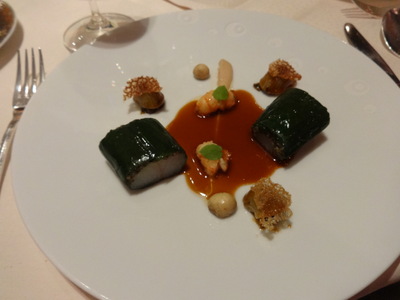
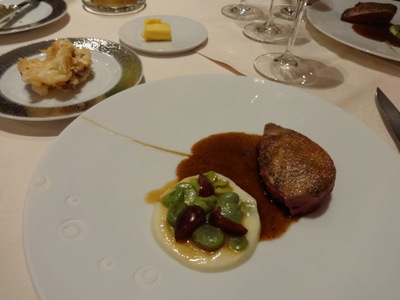 The fifth was St. Pierre (John Dory, a fish) topped with a finely minced mixture of musrooms and something else(langoustines?) and wrapped in leaves (Swiss chard, I think). Around it were arranged several small mushrooms, some filled with the same minced mixture and a couple of langoustine tails. The sauce is a rich seafood reduction.
The fifth was St. Pierre (John Dory, a fish) topped with a finely minced mixture of musrooms and something else(langoustines?) and wrapped in leaves (Swiss chard, I think). Around it were arranged several small mushrooms, some filled with the same minced mixture and a couple of langoustine tails. The sauce is a rich seafood reduction.
Sixth was pigeon—a half breast, roasted rare and sauced with one of those reduction sauces so rich it makes the corners of your mouth sticky. The white disk is celery-root purée topped with a ragout of baby fava beans and slivers of what I at first thought were olive but turned out to be black cherry.
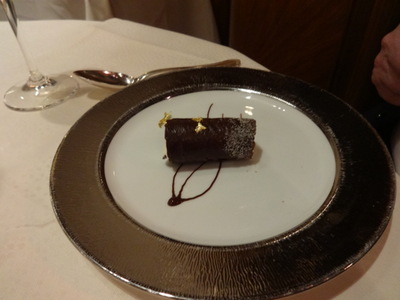
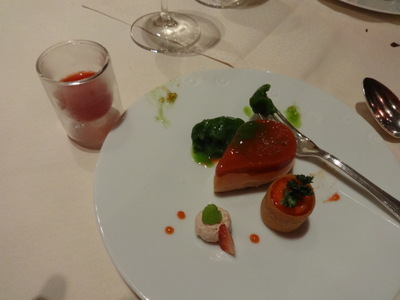 The first dessert, a great classic of the house, was the "cigar." It was a crisp cookie cylinder (note how they powdered one end with sugar to represent the ash on the lit end) filled with pastry cream. Both the cookie and the cream, they claim, are made with real tobacco from a Cuban cigar. Not a lot of it, is my impression. Anyway, it's delicious. I just wish that they (and so many other chefs) would insist on topping desserts with gold leaf, which plays havoc if it gets on my silver-amalgam fillings and which I must therefore laboriously scrape off before eating the dish.
The first dessert, a great classic of the house, was the "cigar." It was a crisp cookie cylinder (note how they powdered one end with sugar to represent the ash on the lit end) filled with pastry cream. Both the cookie and the cream, they claim, are made with real tobacco from a Cuban cigar. Not a lot of it, is my impression. Anyway, it's delicious. I just wish that they (and so many other chefs) would insist on topping desserts with gold leaf, which plays havoc if it gets on my silver-amalgam fillings and which I must therefore laboriously scrape off before eating the dish.
The second and final dessert was theme and variations on strawberry—a variety of juices, mousses, compotes, gels, etc., served with a quenelle of vibrant green (and delicious) sweet parsley sorbet. Note the little sodden lump of gold leaf on the edge of the plate.
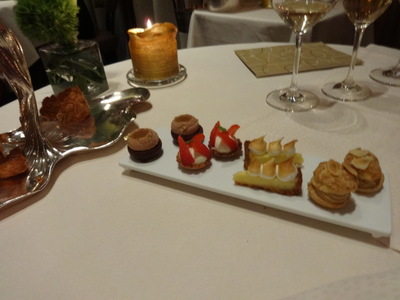
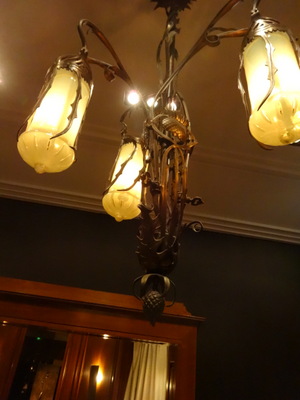 But the final dessert is never the end in places like this. Next came the mignardises: mini Paris-Brests (cream puffs filled with almond-brittle-flavored cream), tiny slices of lemon tart topped with little peaks of meringue browned with a blow-torch, strawberry cream tarts, and chocolate-covered chocolate ganache with a puff of chocolate mousse on top. On the separate silver dish are the houses better-than-most almond tuile cookies. All delicious, I'm sure, but we left most of it on the table.
But the final dessert is never the end in places like this. Next came the mignardises: mini Paris-Brests (cream puffs filled with almond-brittle-flavored cream), tiny slices of lemon tart topped with little peaks of meringue browned with a blow-torch, strawberry cream tarts, and chocolate-covered chocolate ganache with a puff of chocolate mousse on top. On the separate silver dish are the houses better-than-most almond tuile cookies. All delicious, I'm sure, but we left most of it on the table.
Overhead in the lobby was this chandelier featuring thistles. I had to translate our name for the hostess to explain why I was taking photos of the ceiling!
As we left, Chef Rostang shook our hands at the door and presented us with a large sugared brioche for the next morning's breakfast. It proved to be stuffed with those red-sugar-coated peanuts that the French go wild over and are usually associated with county fairs.
Previous entry List of Entries Next entry